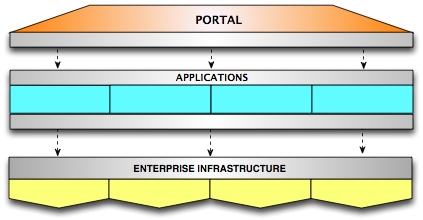.LRN provides a comprehensive suite of collaboration tools, a flexible toolset for innovation, and an enterprise-class infrastructure for scalable deployment.
.LRN "out-of-the-box" consists of a robust portal system, a comprehensive suite of collaborative applications, and an enterprise infrastructure layer based on open standards.

Product Design Philosophy
The .LRN system and its architecture are based on five foundational ideas.
- Learning is inherently social and takes place most sucessfully in the context of communities. Because each learning community has its own stakeholders and needs to define its own unique set of interactions and collaborations, a learning platform must be flexible to support a diversity of learning communities. .LRN was built from the ground up as a platform for supporting "learning communities" rather than a narrow system exclusively for "course management" or "online learning ".
- There is no "right" pedagogical model for learning. The instructor and the learner should have maximum flexibility in shaping the learning environment and the overall experience based on individual needs and the learning context. .LRN supports a variety of learning styles and modes, ranging from traditional structured learning to group collaboration.
- The source of innovation is the user, not the manufacturer. .LRN's modularity allows organizations to add new components and applications quickly and cost-effectively as they discover new needs or when their business processes change.
- Successful online communities (learning communities even more so) must provide extra-ordinary amount of feedback to participants and administrators. In most learning systems assessment is a narrow implementation of a much richer notion of interactive feedback. .LRN supports an extensible data model that accommodates rich feedback at every level of system use.
- Every organization should be able to afford a sophisticated learning system. In looking at the total cost of ownership equation, one of the largest "hidden costs" is enterprise integration and support. Just as printer manufacturers make the lion's share of profit from toner cartridges and not the printer, commercial learning systems provide a low-cost entry point but reap large profits with "add-ons" and enterprise integration features once they have achieved "lock-in" with customers. As an enterprise-class platform, .LRN provides an investment path where organizations can focus their precious resources on people and curriculum development.
Software Development Process
The .LRN software development process follows two stages. At the first stage components are made available by the community and released as .LRN "compatible". .LRN-compatible code is shared by developers and institutions in the spirit of collaboration but is in various degrees of readiness or maturity. At the second stage, the most promising code is released by the consortium as "certified" code. .LRN certified code is released only after running stably in a production setting at a consortium member site and verified after a thorough review process.
Current Release, .LRN Version 2.4.1
The current .LRN Release 2.4.1 new features are:
- HTML 4.01 Strict
- WCAG double-A compliant
- Accessibility improved
- Calendar UI Improved
- Categorization in File-Storage
- Oracle support for Views
Also contains forum, file storage, calendar, news, survey, FAQ, homework dropbox, and group email. Modules for weblogs, assessment, RSS news aggregator, html editor, web powerpoint, complex survey, photo-album, and learning object repository are also available but not yet certified for release. At the infrastructure level, the current release contains provisions for both basic and external authentication, permissioning, general notifcations, internationalization, content management, and WebDAV. .LRN compatible code is also available which uses RSS, Web Services, Learning Object Repository System, and various components based on IMS and SCORM standards.
Below is a detailed architecture diagram:

